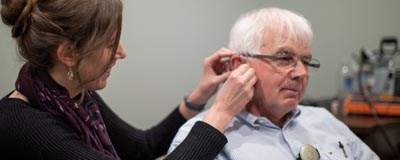(article from Ottawa Citizen)
I dreaded my first hearing test, but I’m glad that I had it done. Nearly one-quarter of the Canadian adult population report having some hearing loss. This percentage increases with age. Early detection of hearing impairment is vital, but a hearing test is something that many people, myself included, put off. While we make appointments for regular checkups for our eyes and teeth, we do not take our hearing as seriously. However, hearing properly is serious! One recent study reported that seniors with an untreated moderate hearing loss were three times as likely as those with normal hearing to develop dementia (2011, Lin).
I am middle-aged, and I am a heavy listener of loud music. I was not sure my hearing was intact. The signs were subtle. I needed to have the television a bit louder than the rest of my family. I sometimes didn’t hear the dog yip to go out. So I booked an appointment at one of Davidson Hearing Aid Centres’ seven locations to find out. I was pleasantly surprised to learn that a comprehensive hearing evaluation, by an audiologist, is completely free.
Audiologist Robbie Davidson, a grandson of the company’s founder, greeted me with a wide smile and led me into one of the clinic’s professional pale blue offices. To begin the hearing test, Davidson used an otoscope to peer into the outer ear canals to ensure that there were no obstructions or irregularities.
For the next step, I was seated in a comfortable chair in a glass-walled sound room, with the door ajar and a set of headphones. Davidson sat at a desk in front of the audiometer, a small testing machine. Seven different beeping sounds, varying in pitch, were played in each ear. I was asked to raise my hand to identify each sound as they descended in intensity, growing so faint that they sounded ghostly and barely audible. In conjunction, a tympanometry examination, which took less than 30 seconds, was used to measure the mobility of my eardrum and to evaluate the health of the middle ear. Davidson then changed the set of headphones to one that sat behind my ear, and I was asked to listen and respond to sounds through the bone vibration of my head. Next came a word recognition test consisting of spoken words, first in the right ear, then in the left, that gradually became difficult to identify and repeat. Finally, I was asked to reiterate spoken phrases by discriminating them from a background of competing voices. The background noise slowly grew so loud that it was impossible to separate the sounds. I was beginning to feel concerned.
Davidson explained, in easy-to-understand language, the audiometry test results. My hearing is good, although there is a slight drop-off in the right ear at the highest frequency level. This decline in hearing is age-related. I don’t need a hearing aid —yet. “It is a good idea for all adults over 55 to have a baseline hearing test done and to have it monitored for change every few years,” Davidson advised.
Unlike many clinics who only work with a few hearing aid manufacturers, Davidson Hearing Aid Centres’ team of audiologists and hearing instrument specialists help their patients select the best hearing aids from 11 different manufacturers, based on hearing requirements, lifestyle and budget.
“Listening experiences have drastically improved in the last five years, and the technology is constantly evolving,” Davidson explained. Today’s hearing aids offer increased noise-reduction, smaller and more comfortable designs, and adjustable directional microphones. Wireless communication using Bluetooth allows hearing aid wearers to listen to TV’s, stereos, computers, and phones directly through their devices. There are exciting new apps. With a simple tap on the iPhone or iWatch, the user can adjust the base or treble, or set the device for different environments, such as a noisy restaurant, or to block the wind outdoors.
Hearing loss can affect communication, quality of life, learning, and job performance. A hearing aid is life changing. “A patient recently told me that the biggest surprise for him was how much more energy he had after getting his new hearing aids. He wasn’t straining to hear his grandchildren’s soft voices, asking them to repeat, or worse yet, guessing. He didn’t feel nearly as tired at the end of their visits,” Davidson explained.
Hearing aids come in many price ranges. Most hearing units, which are quite tiny, can be fit into six different hearing aid casings, ranging from slightly visible to completely invisible in the ear.
At Davidson Hearing Aid Centres, the initial price for the lifetime of a hearing aid includes a 90-day guarantee, manufacturer warranties, loss and damage coverage, and a three-year supply of batteries for many models. Best of all, follow-up testing and ear health appointments, adjustments and most in-house repairs are included.
“Hearing loss usually happens gradually and does not affect all sounds by the same amount. This typically means that certain people’s voices can be heard, while other people will sound like they are mumbling, ” Davidson explained. The hearing test results helped explain my mild symptoms. I now see that a visit to my audiologist is as important as my routine visits to my dentist or optometrist. The baseline hearing test was easy and non-invasive. I am so glad I had it, and I will continue to have regular hearing tests.
For more information or to schedule a free hearing test, click here
Study: Hearing loss and incident dementia, Lin et al, Arch Neurol. 2011 Feb;68(2):214-20. doi: 10.1001/archneurol.2010.362







